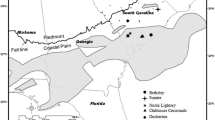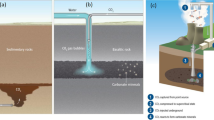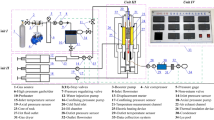Abstract
The Triassic–Jurassic South Georgia Rift (SGR) Basin, buried beneath Coastal Plain sediments of southern South Carolina, southeastern Georgia, western Florida, and southern Alabama, consists of an assemblage of continental rift deposits (popularly called red beds), and mafic igneous rocks (basalt flows and diabase sills). The red beds are capped by basalts and/or diabase sills, and constitute the target for supercritical CO2 storage as part of a Department of Energy funded project to study the feasibility for safe and permanent sequestration. The purpose of this research is to evaluate subsurface suitability for underground CO2 storage in terms of the local and regional distribution of porous and permeable reservoirs. In addition, unlike shale-capped CO2 reservoirs, very little is known about the ability of basalts and diabase sills to act as viable seals for CO2 storage. New results demonstrate the presence of confined porous rocks that may be capable of storing significant quantities of supercritical CO2. Reservoir thicknesses as high as 420 m and an average porosity as high as 14 % were obtained. The SGR Basin manifests distinct porosity–permeability regimes that are influenced by the depositional environments. These are: a high-porosity, medium/low-permeability zone associated with lacustrine deposits, a medium/low-porosity, low-permeability zone dominated by fluvial fine- to very fine-grained sandstone, and an extremely low porosity and permeability zone characterized by fluvial and alluvial-fan deposits. Analyses further show that the basalt flows and diabase sills are characterized by low porosity as well as high seismic velocities and densities that are favorable to caprock integrity.











Similar content being viewed by others
References
Akintunde OM, Knapp C, Heffner DM, Knapp JH, Shafer J (2011) Reinterpretation of the “J” basalt reflector from seismic data reprocessing across the coastal plain of southeastern Georgia: potential implications for long-term CO2 sequestration. AAPG, Annual Convention and Exhibition, Houston, Texas, AAPG Search and Discovery Article #80174
Akintunde OM, Knapp CC, Knapp JH, Heffner DM (2013) New constraints on buried Triassic basins and regional implications for subsurface CO2 storage from the SeisData6 seismic profile across the South East Georgia Coastal Plain. Environ Geosci 20(1):1–13
Albritton DL, Meira Filho LG (2001) The scientific basis: contribution of working group I to the third assessment report of the intergovernmental panel on climate change technical summary. IPCC, Geneva
Bachu S, Gunter WD, Perkins EH (1994) Aquifier disposal of CO2: hydrodynamic and mineral trapping. Energy Convers Manag 35:269–279
Burruss RC, Brennan ST, Freeman PA, Merrill MD, Ruppert LF, Becker MF, Herkelrath WN, Kharaka YK Neuzil CE, Swanson SM, Cook TA, Klett TR, Nelson PH, Schenk CJ (2009) Development of a probabilistic assessment methodology for evaluation of carbon dioxide storage: USGS, Open File Report 1035, pp 1–44
Chowns TM, Williams CT (1983) Pre-Cretaceous rocks beneath the Georgia Coastal plain—regional implications. In: Gohn GS (ed) Studies related to the Charleston, South Carolina, earthquake of 1886—tectonics and seismicity: US Geological Survey Professional paper 1313, pp L1–L42
Core Laboratories (1984) Analysis report. Texaco Inc. Essex Exploration and Production Company, Norris C. Lightsey No. 1 Well Wildcat, Collenton County, South Carolina
Daniels DL, Zietz I, Popenoe P (1983) Distribution of subsurface lower Mesozoic rocks in the Southeastern United States as interpreted from regional aeromagnetic and gravity maps. In: Gohn GS (ed) Studies related to the Charleston, South Carolina earthquake of 1886-Tectonics and Seismicity. U.S. Geological Survey Professional Paper 1313, pp K1–K24
DOE (2008) Methodology for development of geologic storage estimates for carbon dioxide, DOE Regional Carbon Sequestration Partnerships, pp 27–30
EIA (2007) Short-term energy outlook-June 2007. Energy Information Administration (EIA), Washington
Gohn GS (1983) Geology of the basement rocks near Charleston, South Carolina—data from detrical rock fragments in lower Mesozoic(?) rocks in Clubhouse Crossroads test hole #3. In: Gohn GS (ed) Studies related to the Charleston, South Carolina, earthquake of 1886—tectonics and seismicity: US Geological Survey Professional Paper 1313, pp E1–E22
Gohn GS, Houser BB, Schneider RR (1983) Geology of the lower Mesozoic(?) sedimentary rocks in Clubhouse Crossroads test hole #3 near Charleston, South Carolina. In: Gohn GS (ed) Studies related to Charleston, South Carolina earthquake of 1886—tectonics and seismicity: US Geological Survey Professional Paper 1313, pp D1–D17
Goldberg DS, Kent DV, Olsen PE (2010) Potential on-shore and off-shore reservoirs for CO2 sequestration in Central Atlantic Magmatic Province Basalts (CAMP). PNAS 107(4):1327–1332
Gottfried D, Annell CS, Byerly GR (1983) Geochemistry and tectonic significance of subsurface basalts near Charleston, South Carolina; Clubhouse Crossroads test holes #2 and #3. In: Gohn GS (ed) Studies related to Charleston, South Carolina earthquake of 1886—tectonics and seismicity: US Geological Survey Professional Paper 1313, pp A1–A19
Grana D, Della Rossa E (2010) Probabilistic petrophysical properties estimation integrating statistical rock physics with seismic inversion. Geophysics 75(3):O21–O37
Hames WE, Renne PR, Ruppel C (2000) New evidence for geologically instantaneous emplacement of earliest Jurassic Central Atlantic magmatic province basalts on the North American margin. Geology 28(9):859–862
Heffner DM, Knapp JH, Akintunde OM, Knapp C (2012) Preserved extent of Jurassic flood basalt in the South Georgia Rift: a new interpretation of the J horizon. Geology 40(2):167–170
Hovorka SD, Smyth RC, Paine J, Tinker S, Duncan I (2006) Downscaling capacity estimates from a regional to a site scale—case study in the South Eastern US Gulf Coast Carbon Center at the Bureau of Economic Geology. University of Texas, Austin
Ketcham RA, Carlson WD (2001) Acquisition, optimization and interpretation of X-ray computed tomographic imagery: applications to the geosciences. Comput Geosci 27:381–400
Koide H, Tazaki Y, Noguchi Y, Nakayama S, Iijima M, Ito K, Shindo Y (1993) Subterranean containment and long-term storage of carbon dioxide in unused aquifers and in depleted natural gas reservoirs. Energy Convers Manag 33(5–8):619–626
Lanphere MA (1983) 40Sr/39Ar Ages of basalt from clubhouse crossroads test hole #2, near Charleston, South Carolina, Earthquake of 1886—tectonics and seismicity. United States Geological Survey Professional Paper 1313, pp B1–B8
Lindholm RC, Hazlett JM, Fagin SW (1979) Petrology of Triassic-Jurassic conglomerates in the Culpeper basin,Virginia. J Sediment Petrol 49(4):1245–1261
Lucier A, Zoback MD, Gupta N, Ramakrishnan TS (2006) Geomechanical aspects of CO2 sequestration in a deep saline reservoir in the Ohio River Valley region. Environ Geosci 13:1–19
Lumley D, Sherlock D, Daley T, Huang L, Lawton D, Masters R, Verliac M, White D (2010) Highlights of the 2009 SEG summer research workshop on CO2 sequestration. Lead Edge 29(02):138–145
Marine W (1974) Geohydrology of buried Triassic basin at Savannah River plant, South Carolina. Am Assoc Pet Geol Bull 58(9):1825–1837
Marine W, Siple GE (1974) Buried Triassic basin in the central Savannah River area. Geol Soc Am Bull 85:311–320
Mavko G, Mukerji T, Dvorkin J (2003) The rock physics handbook. Cambridge University Press, UK
McBride JH, Nelson KD, Brown LD (1989) Evidence and implications of an extensive early Mesozoic rift basin and basalt/diabase sequence beneath the southeast Coastal Plain. Geol Soc Am Bull 101:512–520
McGrail BP, Schaef HT, Ho AM, ChienY, Dooley JJ, Davidson CL (2006) Potential for carbon dioxide sequestration in flood basalts. J Geophys Res 111:1–13. Article No B12201
Miall AD (1996) The geology of fluvial deposits. Springer, Berlin
Nelson PH (2004) Permeability-porosity data sets for sandstones. Lead Edge 23:1143–1144
Olsen PE, Froelich AJ, Daniels DL, Smooth JP, Gore JW (1991) Rift basins of early mesozoic age, the geology of the Carolinas, Carolina Geological Society 50th Anniversary Volume, pp 142–170
Petersen TA, Brown LD, Cook FA, Kaufman S, Oliver JE (1984) Structure of the Riddleville basin from COCORP seismic data and implications for reactivation tectonics. J Geol 92:261–271
Planke S, Alvestad E, Eldholm O (1999) Seismic characteristics of basaltic extrusive and intrusive rocks. Lead Edge 18:342–348
Prasad M (2002) Acoustic measurements in unconsolidated sands at low effective pressure and overpressure detection. Geophysics 67(2):405–412
Prasad M (2003) Velocity-permeability relations within hydraulic units. Geophysics 68(1):108–117
Reid MS, Aucott RW, Lee RW, Renken RA (1986) Hydrologic and geologic analysis of a well in Dorchester County, South Carolina: US Geological Survey Water-Resources Investigation Report 86-4161, p 23
Schaef HT, McGrai BP, Owen AT (2009) Basalt-CO2-H2O interactions and variability in carbonate mineralization rates, science direct. Energy Procedia 1:4899–4906
Schon JH (2011) Physical properties of rocks. Elsevier, UK
Smyth RC (2007) Potential sinks for geologic storage of carbon dioxide generated in the Carolinas. US Bureau of Econ Geol, Summary Report 1–14
Spikes K, Mukerji T, Dvorkin J, Mavko G (2007) Probabilistic seismic inversion based on rock-physics models. Geophysics 72(5):R87–R97
Tans P (2012) Trends in atmospheric carbon dioxide at Mauna Loa. US Department of Commerce NOAA (National Oceanic and Atmospheric Administration). http://www.esrl.noaa.gov/gmd/ccgg/trends/. Accessed 27 December 2012
Traverse (1987) Pollen and spores date origin of rift basins from Texas to Nova Scotia as early late Triassic. Science 236:1469–1472
Wyllie MRJ, Gregory AR, Gardner LW (1956) Elastic wave velocities in heterogeneous and porous media. Geophysics 21:41–70
Ziegler PA (1983) Hydrocarbon potential of the Newark rift system: eastern North America. Northeast Geol 5(3/4):200–208
Acknowledgments
We thank John Shafer, Mike Waddell, Adrian Addison, Duke Brantley and Mark Evans from the Earth Sciences Resources Institute (ESRI), Columbia, South Carolina as well as David Heffner, Department of Earth and Ocean Sciences, University of South Carolina, for their contributions to this work. Also, we thank Scott Howard and Bill Clendenin of the South Carolina State Geological Survey for unrestricted access to the sandstone cores that we used. Basalt samples from Clubhouse Crossroads were provided by Paul Olsen of Lamont-Doherty Earth Observatory, Columbia University, New York. The Well logs from Norris Lightsey #1 were provided by the Southern Company based in Georgia. Our appreciation also goes to Manika Prasad and Mike Batzle, Colorado School of Mines, Golden, Colorado for permission to use their laboratory facilities. X-ray computed tomographic images were acquired by George Radziszewski of the Colorado School of Mines (basalt samples) and by Jessica Maisano and the UT Austin XCT team (Palisade/Diabase sills). XRD analysis was performed by the Mineral Lab Inc, in Golden Colorado. Thin section and photomicrograph on the Dorcehster-211 basalt sample were provided by James Rine of the Weatherford Laboratories in Houston, Texas. Darrell Terry, Department of Earth and Ocean Sciences, University of South Carolina, provided helpful review and comments.
Author information
Authors and Affiliations
Corresponding author
Additional information
This material is based upon work supported by the United States Department of Energy (DOE) under Award Number DE-FE0001965. This paper was prepared as an account of work sponsored by an agency of the United States Government. Neither the United States Government nor any agency thereof, nor any of their employees, make any warranty, express or implied, or assumes any legal liability or responsibility for the accuracy, completeness, or usefulness of any information, apparatus, product, or process disclosed, or represents that its use would not infringe privately owned rights. Reference herein to any specific commercial product, process, or service by trade name, trademark, manufacturer, or otherwise does not necessarily constitute or imply its endorsement, recommendation, or favoring by the United States Government or any agency thereof. The views and opinions of authors expressed herein do not necessarily state or reflect those of the United States Government or any agency thereof.
Rights and permissions
About this article
Cite this article
Akintunde, O.M., Knapp, C. & Knapp, J. Petrophysical characterization of the South Georgia Rift Basin for supercritical CO2 storage: a preliminary assessment. Environ Earth Sci 70, 2971–2985 (2013). https://doi.org/10.1007/s12665-013-2355-6
Received:
Accepted:
Published:
Issue Date:
DOI: https://doi.org/10.1007/s12665-013-2355-6




